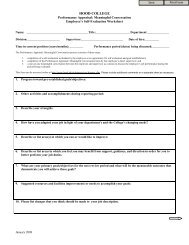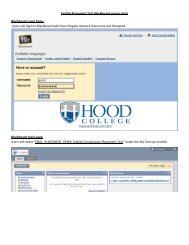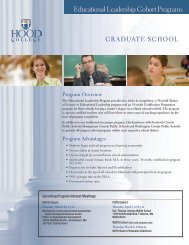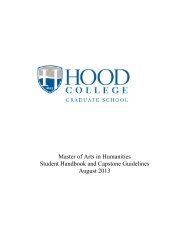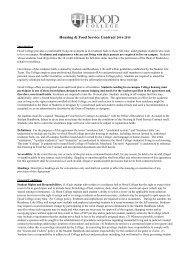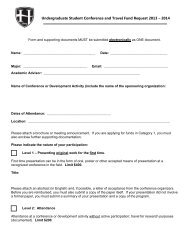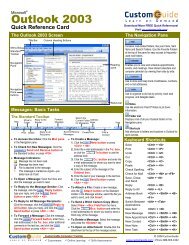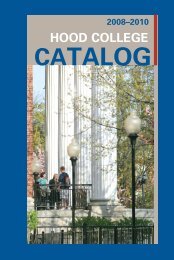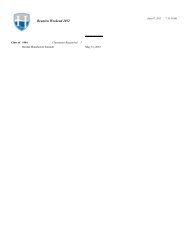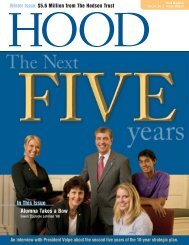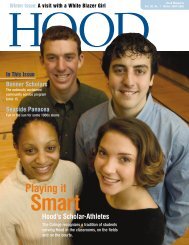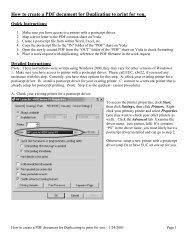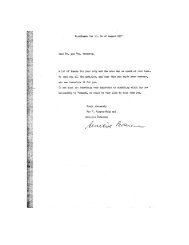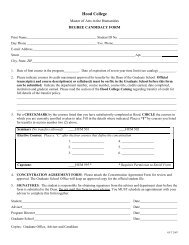Summer 2007 - Hood College
Summer 2007 - Hood College
Summer 2007 - Hood College
Create successful ePaper yourself
Turn your PDF publications into a flip-book with our unique Google optimized e-Paper software.
<strong>Summer</strong> <strong>2007</strong><strong>Hood</strong> Magazine 13C A M P U S L I F Esaid. “Ten years ago, we worried about beingable to hold a class. Now we don’t worryabout filling these classes anymore.”He said the dynamics in the classroomhave changed and he is pleased with the typeand quality of students <strong>Hood</strong> continues toattract. “One of the best things about thegrowth is that we have a greater critical massand core of committed students.”However, out of necessity, studio art andseminar-type courses in his department onaverage tend to be somewhat smaller—andshould stay that way. Seminar classes havegrown from about 6-8 students each to about12-13. “In class I also try to involve discussion;it’s an important component that youtry to have but you can’t do it equitably withlarger classes,” he said. “Students learn themost if they are a part of the process.”Even with the exponential growth of thestudent body, some things aren’t changing at<strong>Hood</strong>, Markey said. Class sizes still average17 or 18 students, with the smaller classesgenerally at the junior and senior levels.Bohrer, who agrees with Funk, has nocomplaints about the extra out-of-class work.“More students means I have a lot moreessays to grade than I used to. But that’s theonly way the students are going to learn anything.We have to have that. We are notgoing to cut corners.”Classes in the economics and managementdepartment have grown substantially,but nothing like the classes of 500 that SangKim, associate professor of economics andmanagement, taught at the University of theWest Indies. He said he is teaching classesthat range between 25 and 40 students,which are about double the size of classes hetaught when he came to <strong>Hood</strong> in 2001.Kim said the proliferation and use of classroomtechnology and the Internet havehelped reduce his workload and allowed himto do his classroom preparation more quicklyand from wherever he wants. “It’s helpful ingeneral and also helpful in larger classes,” hesaid. Immediate access to the Internet allowsKim to retrieve relevant information, data andexamples in the classroom. “As the Webdevelops, there are some very nifty things outthere. It really makes a difference. In theclassroom, I can show students how things aredone, and we can go directly to the latestinflation figures versus preparing slides andshowing them.” ■A beautiful spring day on the lawn is an ideal setting for Elizabeth Lipke ’08 and her classmates.Campus life more vibrant than everBy Tammy McElroy ‘05, Assistant EditorOutside of the classrooms, laboratories,studios and seminar rooms, the changesresulting from the growth in the studentbody are abundant and varied. Most noticeableis the greater number of students, at anytime of day, on the quadrangles, in the dininghall, in the bookstore, cheering on anyone of the 19 NCAA athletic teams on anygiven afternoon or trying to locate the everharder-to-findparking spaces.When Whitaker Campus Center firstopened its doors in 1997, it was a welcomedand needed addition to the campus thatwould enhance student life for the 1,022undergraduates and 834 graduates attending<strong>Hood</strong>. A decade later, the campus center hasfulfilled its promise of adding to the campusexperience, and more. These days, however,it is a far busier place with the addition of238 residential students to the campuspopulation since 2002.“The increase in the number of studentshas altered the campus and changed the waystudents use the campus center and justabout every other space on campus,” saidDon Miller, <strong>Hood</strong>’s director of studentactivities. “A college’s campus center is its‘living room’ and Whitaker has transformedinto that. Because we have outgrown someof our spaces for programming, there hasbeen a much-needed shift in terms of locationand resources. New spaces have beencreated and traditionally used ones havebeen utilized in other ways.”The campus center remains that centralmeeting place but it has become much busierand is a hub for student activity. More thanever before, students make good use of thecampus center’s abundant spaces for studying,sharing a meal from the Blazer snackbar, watching TV, playing ping-pong orpool, using the 24-hour computer lab or justhanging out. The Commons and Atriumserve as multipurpose areas for events rangingfrom residence hall parties to specialdinners; the Patio is used for outdoor eventssuch as barbecues and student-organizedconcerts.The demand for more and betterstudent areas is the impetus for majorimprovements to Rosenstock HallAuditorium. Built in 1970 and able to seat389 people, it is in greater demand than everbefore as a venue for student activities, per-



